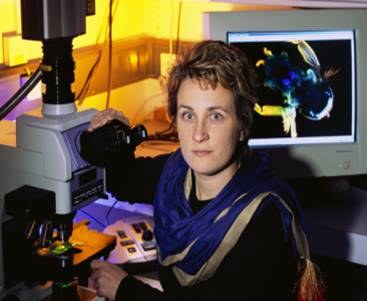Open source 3D-printed microscope
Many tasks in biology require tiny, accurate motion – achieved with expensive hardware. We have used inexpensive, 3D printed parts to make high performance mechanisms for low cost science. Our best example is a microscope small and cheap enough to be left in an incubator or fume hood for days or weeks. This will enable new science, for example by observing cells as they grow in an incubator. We will improve this microscope’s imaging capabilities (adding fluorescence and phase contrast) and demonstrate its use in an incubator. We will also show that printed mechanisms can be used for other tasks, for example the mechanical manipulation of micropipettes for microinjection or patch clamping.
The Idea
Optical microscopy is fundamental to biology, and relatively high performance microscopes can now be made very cheaply. Positioning the sample and focusing the objective, however, is difficult without expensive translation stages: a microscope is mostly mechanics. Many other tasks in biology require tiny, accurate motion – achieved with expensive hardware such as mechanical micromanipulators and piezoelectric actuators. We have used inexpensive, 3D printed parts to make high performance mechanisms for low cost science, and we propose to apply this technology to problems in synthetic biology.
Our best example is a microscope small and cheap enough to be left in an incubator or fume hood for days or weeks. This will enable new science, for example by observing cells as they grow in an incubator – experiments which are currently impossible to do on a large scale due to the time and resources required. We will improve this microscope’s biological imaging capabilities (adding fluorescence and phase contrast) and demonstrate its use in an incubator at the Light Microscopy Facility in the Cancer Research Institute. This will then allow us to study phototoxicity by monitoring cultures of cells over several days.
Plastic flexure technology could also reduce the cost of mechanical micromanipulators by three orders of magnitude, opening up a range of possibilities. When combined with open-source Arduino microcontrollers, it is even possible to automate these devices for around £100. We will develop and test plastic micromanipulators for microinjection or electrophysiology, and assess their precision and stability. We will also investigate the use of ABS plastic as a potential replacement for PLA, as it has the potential to further improve the performance of printed mechanisms.
Finally, these low cost devices present obvious opportunities for science outreach, and this funding would enable us to create a class set of microscopes that can be taken (or lent) to schools as part of outreach activities, along with some fixed samples and lesson plans for easily-prepared specimens.
The Team
Dr Richard Bowman
Richard is a Physics Research Fellow in the Nanophotonics Centre at the Cavendish Laboratory and has a background in optical tweezers and microscopy.
Dr Stefanie Reichelt
Stefanie is Head of Light Microscopy at Cancer Research UK.
Dr Hugh Matthews
Dr Hugh Matthews is Reader in Sensory Physiology and his research interests include phototransduction and olfactory transduction. Calcium homeostasis in vertebrate photoreceptors and olfactory receptors, and its role in modulating their electrical responses. Light-induced calcium release within the photoreceptor outer segment.
Prof Jeremy Baumberg
Jeremy Baumberg is a leader in nanoscience and nanotechnology, working for much of his career at the interface between academia and industry. He is Professor of Nanophotonics and Director of the Nanophotonics Centre.
Project Outputs
Project Report
Summary of the project's achievements and future plans
Project Proposal
Original proposal and application Download PDF >>
OpenFlexure Scope DocuBricks
Full open source documentation for the hardware build on the DocuBricks site (also supported by SynBio Fund.
OpenFlexure Scope on github
Design files and documentation for the OpenFlexure Scope.
Open Access Paper
Sharkey, James P., et al. "A one-piece 3D printed flexure translation stage for open-source microscopy." Review of Scientific Instruments 87.2 (2016): 025104.
Project Impact and Further Activities
- Waterscope: Richard Bowman and co-founders started WaterScope, a social enterprise developing the microscope for water contamination testing in developing countries. They have since gone on to win several business and enterprise awards and obtain funding for a full-time employee and field work in Tanzania, where local partner STICLab have started printing the microscopes in-country. The team now also sell microscope kits.
- OpenScope: The Cambridge-JIC iGEM 2015 team built on the Open Flexure scope with their OpenScope project, redesigning the stage for inverted microscopy and fluorescence. View their documentation on the iGEM wiki and follow the progress of the project via the Cambridge University Synthetic Biology Society, founded in 2015 to continue the work of the iGEM team and offer up opportunities for student led engagement with synthetic biology projects.
Project progress update
Abstract
Many tasks in biology require tiny, accurate motion – achieved with expensive hardware. We have used inexpensive, 3D printed parts to make high performance mechanisms such as a compact mechanical stage, enabling an inexpensive microscope. This project aimed to improve the microscope (higher resolution imaging, fluorescence, phase contrast) and also to demonstrate other devices including a micro manipulator, suitable for use in electrophysiology for patch clamping or microinjection.
Goals
The project had the following goals for outcomes:
- Improving microscope’s biological imaging capabilities (adding fluorescence and phase contrast) The basic configuration of our microscope uses transmission illumination: this gives bright-field images, suitable for observing many transparent samples. Adding a condenser lens in a printed holder allowed dark-field and basic phase contrast imaging, allowing a greater range of samples to be observed (See Figure 1).
The inverted design of the microscope means that samples are generally imaged through slides or coverslips. Inverted microscopes work well with a wide range of samples, including cell cultures and microtomed specimens. Adding fluoresence imaging is still a work in progress - Use in an incubator at the Light Microscopy Facility in the Cancer Research Institute.
- Plastic micromanipulators for microinjection or electrophysiology
- Use of ABS plastic as a potential replacement for PLA, as it has the potential to further improve the performance of printed mechanisms.
- Science outreach kit
Outcomes
1. Open-source documentation
There are now full, illustrated assembly instructions available at docubricks as well as all source files available from GitHub. The GitHub repository contains the latest releases, in DocuBricks format, as well as the cutting-edge development options which include designs for use with RMS standard microscope objectives, and fluorescence filter mounts.
An extensive mechanical characterisation was performed by James Sharkey during his Part III project, which formed the basis of a publication describing the microscope’s mechanical design. This has been made open-access thanks to the SynBioFund grant.
2. Improved Imaging
The basic microscope design employs a webcam lens, taken from v1 of the Raspberry Pi camera module. v2 of the camera module already represents significantly improved resolution (by about 50%) due to its superior optics. However, for many scientific and medical applications it’s necessary to go beyond what is possible with a webcam lens. There is now a larger version of the microscope, capable of accepting an RMS standard objective (4x-100x have been tested, and work). This is used together with a 40mm planoconvex lens to correct for the shorter tube length and small sensor, to make the Raspberry Pi sensor cover the same field of view as a camera sensor 14.4x10.8mm in size (somewhere between a 1” and 4/3” video sensor) connected to a conventional lab microscope.
Fluorescence was demonstrated during Darryl Foo’s vacation project on the microscope, and has been re-integrated into the high-resolution objective-based design in a branch of the GitHub repository. This design will be used by the OpenPlant project “Establishing 3D Printed Microfluidics for Molecular Biology Workflows”.
Dark field and basic phase contrast imaging have been demonstrated in prototype designs, however we have not yet standardised and documented the build process for these. Both of these enhancements should be able to be made much more reproducible with our printed, adjustable condenser module which is present in the development branches on GitHub although not yet part of the documented releases.
Figure 1. A microtomed section of Pollia condensata fruit imaged in (a) bright field and (b) dark field modes. (c) The imaging optics in the microscope, showing optional condenser lens and dark field stop. Removing the dark field stop converts the microscope to bright field mode, and removing the condenser lens decreases the brightness but does not prevent the microscope from working.
3. Micromanipulation
A number of variations of the OpenFlexure microscope have been produced to give full 3D motion of an object. Initial designs proved insufficiently stiff, and suffered greatly from coupling between translational and rotational motion. One of these, a delta robot design, was improved and used by the 2015 Sensors CDT cohort as part of their group project, creating an Optical Projection Tomography system(http://cdt.sensors.cam.ac.uk/news/team-project-optical-projection-tomography).
More recently, a new variation on the design incorporating two-stage mechanical reduction has allowed 100nm-scale motion with very low wobble and good orthogonality between axes. It is currently designed in the form factor of a fibre-coupling stage, such as the flexure stages found in many optics laboratories that inspired the original flexure-based microscope. Initial testing suggests it is a very promising design, with sufficient accuracy and stability to be used in aligning single mode optical fibres. This design is on GitHub in development form, though it is yet to be packaged and documented for release.
Outreach
The primary impact of this project so far is the creation of WaterScope, a not-for-profit star-up aiming to use microscopy to bring about better diagnostics for public health and sanitation in the developing world. We are working together with makers in Tanzania (STICLab) and others affiliated with the Tech for Trade network, such as AB3D in Nairobi, to investigate the financial and technical feasibility of producing microscopes locally, freeing them from reliance on imports and the often unreliable supply chain that entails.
We have also worked with Public Lab, a US based organisation aiming to use the microscope as part of an air quality monitoring project. They have reproduced our high-resolution microscope, and are investigating creating a ruggedised case.
Finally, we have taken the microscope to various workshops and school visits, and have worked with a number of collaborators in Cambridge and beyond to test it out widely. We are currently refining the design and working to collate teaching materials around the microscope, which we aim to make available soon.
Expenditure
The initial £4000 budget was divided into:
£1400: open access publication fee for Review of Scientific Instruments paper
£1600: purchase of Ultimaker 2 3D printer (this enabled faster prototyping and had better axis orthogonality than the RepRap machine. It also made some successful ABS prints, and we intended to compare these to PLA ones particularly as regards stability at 37C. Unfortunately the ABS microscopes did not print as well so their performance couldn’t be meaningfully compared.)
£400: purchase of various optical components for testing purposes to achieve higher resolution imaging and fluorescence. Support in kind from WaterScope enabled sourcing of inexpensive objectives from Chinese manufacturers.
£600: consumables for constructing microscopes and testing them, including Raspberry Pis, Camera modules, plastic filament and nuts and bolts.
Plans for follow up
We intend to use the follow-on funding of £1000 to purchase the electronics and hardware to create a set of demo microscopes that might be lent to schools or other organisations in support of outreach or collaboration activities. This will fund the purchase of enough hardware to produce 5-10 microscopes, complete with Raspberry Pis and screens as necessary, which will make it much easier to take demonstrations into schools, etc.










